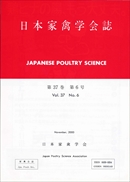All issues

Successor
Volume 38 (2001)
- Issue 6 Pages J131-
- Issue 5 Pages J1-
Current issue
Displaying 1-8 of 8 articles from this issue
- |<
- <
- 1
- >
- >|
-
Takashi Bungo2001 Volume 38 Issue 6 Pages J131-J140
Published: 2001
Released on J-STAGE: November 12, 2008
JOURNAL FREE ACCESSDownload PDF (1394K) -
Kazumi Kita2001 Volume 38 Issue 6 Pages J141-J151
Published: 2001
Released on J-STAGE: November 12, 2008
JOURNAL FREE ACCESSDownload PDF (1610K) -
Kuninori Fujinaka, Ken Tatsuda, Toshinobu Yamasaki2001 Volume 38 Issue 6 Pages J152-J159
Published: 2001
Released on J-STAGE: November 12, 2008
JOURNAL FREE ACCESSA study was made on the technology of refeeding layers. While making it, the basic technology to increase the amount of meat from spent layers by refeeding a broiler diet for 8 days after 4 days of fasting, and an investigation was made on the suitability of shortening the number of fasting days and lengthening the number of fattening days. In Experiment 1, forty 108 week old layers were forced to fast for 0, 2, 4 days, while in Experiment 2, forty 80 week old layers were fattened for 8, 11, 15 days.Then they were compared with the control group that were fed a layer diet.
As a result, the decrease in the laying rate was lower after fasting for 0 and 2 days than when fasted for 4 days. However, the meat weight was lower in the case of 4-day fasting, and the combined revenue from eggs and meat did not exceed the control value. With respect to the fattening days, laying rates of midterm and longterm fattening were slightly higher than that of shortterm fattening. However, meat weight was reduced by increasing the number of fattening days, and the combined revenue decreased after increasing fattening days.
The above results indicate that in refeeding layers through the combination of fasting and fattening, 4-day fasting followed by 8-day fattening was the most efficient for fattening layers.View full abstractDownload PDF (744K) -
Morihiro Koga, Makoto Yamazaki, Hitoshi Murakami, Masahiro Tsuro, Ryoe ...2001 Volume 38 Issue 6 Pages J160-J166
Published: 2001
Released on J-STAGE: November 12, 2008
JOURNAL FREE ACCESSEffects of dietary oil source on β-carotene content in egg yolk and egg yolk color were investigated in laying hens. Twenty seven hens (71-wkold) were divided into three dietary treatment groups, 1) without fat supplementation (control), 2) supplemented with 5%of medium chain triacylglycerols (MCT), 3) supplemented with 5% of long chain triacylglycerols (LCT). Those experimental diets contained O.1% of β-carotene beadlets, and were fed for 28 days.
The β-carotene content of egg yolk increased, and reached a plateau at 7 to 14 days after feeding the experimental diets. At day 21 after feeding, β-carotene contents of egg yolk from hens fed the LCT, MCT supplemented diets and control diet were 441, 248, and 266ug/100g egg yolk, respectively. Efficiency of egg yolk deposition of βcarotene(the ratio of β-carotene retained in egg yolk to β-carotene intake) of hens fed the LCT, MCT supplemented diets and control diet were O.59%, 0.34%, and O.41%, respectively, and significantly increased with hens fed the LCT supplemented diet than hens fed the MCT supplemented diet. Yolk color fan score was significantly decreased with hens fed MCT supplemented diet than hens fed LCT supplemented diet. Egg production and feed conversion ratio were not affected by the dietary oil source.
These results suggest that β-carotene content and efficiency of egg yolk deposition of β-carotene were affected by the dietary oil source, and LCT is more effective to deposit β-carotene in egg yolk than MCT.View full abstractDownload PDF (791K) -
Sumiyo Ishikawa, Masako Tachikawa, Hiroshi Hayakawa2001 Volume 38 Issue 6 Pages J167-J176
Published: 2001
Released on J-STAGE: November 12, 2008
JOURNAL FREE ACCESSOur previous study (part 1) showed that carrot leaf (CL), a farm wasteproduct, fed to laying hens elevated -carotene content and Roche color fan score of egg yolk. The present study was designed to see whether fat inclusion in diets potentiates the CLinduced effects, as described for a chemical product of -carotene. To make diets containing CL isocaloric and to retain -carotene content of CL during its drying, nutrient composition of CL and a useful method to make it dry were determined beforehand. Four diets, a basal diet for laying hens (BDLH, control), BDLH with 5% or 10% added CL, and BDLH with 10% added CL plus soybean oil, were each fed to hens in different blocks for 8 weeks. Supplemental CL had no effect on egg production with a slight reduction in food intake. -carotene content of egg yolk was significantly elevated in blocks fed diets containing CL (P<0.05), and with 10% added CL it was nearly 6 times as high as the control. Neither the CL-induced effect nor the ratio of -carotene retained in egg yolk to the total -carotene intake was increased by supplementation of soybean oil. Roche color fan score of egg yolk was invariably higher in blocks fed diets containing CL than in the control. However, there was no significant difference in the score between 5% and 10% of CL inclusion in diets, suggesting that 5% of CL in diets was high enough to increase the score. Egg weight, haugh unit, eggshape index and strength and thickness of eggshell remained almost unaltered after feeding CL to hens.
These results suggest that CL may be used as a farm product of improving egg quality by which the market value of eggs is elevated, and that the effect of CL is not potentiated by theView full abstractDownload PDF (1161K) -
Minoru Hosoya2001 Volume 38 Issue 6 Pages J177-J181
Published: 2001
Released on J-STAGE: November 12, 2008
JOURNAL FREE ACCESS -
Masaharu Matsuzaki2001 Volume 38 Issue 6 Pages J182-J189
Published: 2001
Released on J-STAGE: November 12, 2008
JOURNAL FREE ACCESSDownload PDF (954K) -
2001 Volume 38 Issue 6 Pages J190-J202
Published: 2001
Released on J-STAGE: November 12, 2008
JOURNAL FREE ACCESSDownload PDF (1202K)
- |<
- <
- 1
- >
- >|